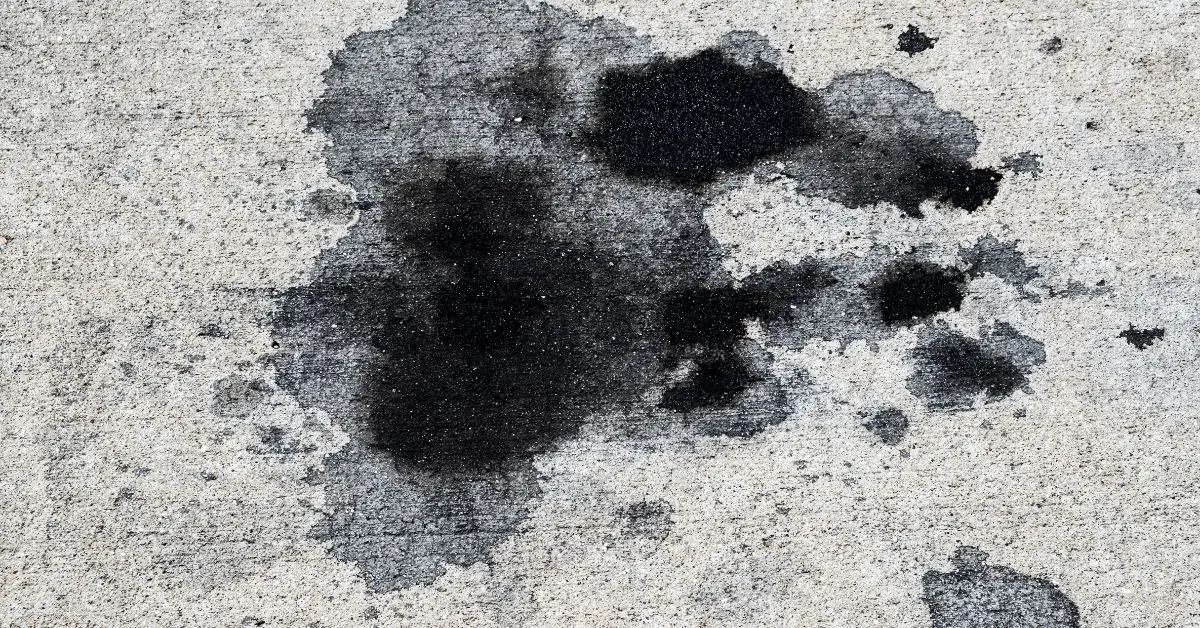
Maintaining the pristine appearance of your concrete driveway is not only about enhancing your home’s curb appeal but also preserving the longevity of the surface. Unfortunately, one common eyesore that many homeowners face is the stubborn presence of old motor oil stains. These unsightly blemishes not only mar the aesthetics of your property but also pose a challenge to your driveway’s overall health.
In this post, we will walk you through the step-by-step process of effectively removing old motor oil stains from your concrete driveway.
Say goodbye to those persistent oil stains and hello to a spotless, inviting entrance that will leave a lasting impression on visitors and passersby. Let’s embark on this journey to rejuvenate your concrete driveway and enhance the appeal of your home.
How to Remove Old Motor Oil Stains from Concrete Driveway

1. Act Quickly with Fresh Stains
When you notice a fresh oil stain on your concrete driveway, it’s essential to act promptly. Cover the stain with an absorbent material like kitty litter or sawdust as soon as possible. This initial step is crucial because it prevents the oil from spreading and seeping deeper into the concrete, making the cleaning process much more manageable.
2. Remove the Absorbent Material
Once the absorbent material has had a chance to soak up the oil and has become saturated, carefully sweep it up and dispose of it properly. Avoid sweeping it back onto the driveway, as this can redeposit oil onto the concrete surface, defeating the purpose of the absorbent material.
3. Apply Detergent
Prepare a cleaning solution by mixing hot water with detergent. Common household options include dish soap or laundry detergent, but you can also use a specialized concrete degreaser if available. A general guideline is to use about one cup of detergent per gallon of hot water. Pour this soapy solution directly onto the oil stain, ensuring that it covers the entire affected area.
4. Scrub the Stain
Take a stiff-bristle brush or a broom with stiff bristles and start scrubbing the oil stain vigorously. Use a circular motion to help lift the oil from the concrete’s surface. Don’t be afraid to put some effort into this step, as thorough scrubbing is essential for breaking down and loosening the oil. For older or more stubborn stains, you may need to repeat this scrubbing process multiple times.
5. Rinse with Hot Water
After scrubbing, it’s crucial to rinse away the detergent and the loosened oil. Use a hose with a strong stream of hot water or buckets of hot water to thoroughly rinse the affected area. Be meticulous about removing all traces of detergent to avoid leaving behind any residue on the concrete.
6. Apply Baking Soda or Talcum Powder
If remnants of the oil stain are still visible after rinsing, you can use an absorbent powder like baking soda or talcum powder to lift the oil further. Sprinkle a generous amount of the powder over the stained area, and allow it to sit for several hours or overnight. The powder will absorb any remaining oil residue.
7. Scrub Again
After the powder has had time to absorb the oil, return to the stain with your stiff-bristle brush or broom. Once again, scrub the area vigorously in a circular motion. This step is essential to help release any oil that the powder has absorbed.
8. Rinse Thoroughly
Rinse the area once more with hot water to remove the powder and any remaining traces of oil residue. A thorough rinse ensures that you leave your concrete driveway clean and free from any cleaning agents or oil remnants.
9. Repeat if Necessary
For particularly stubborn or older oil stains, you may need to repeat the entire cleaning process several times until the stain is completely gone. Patience and persistence are key when dealing with tough stains.
10. Pressure Washing
If you have access to a pressure washer, it can be an incredibly effective tool for removing oil stains from concrete. Follow the manufacturer’s instructions for operating the pressure washer and use a detergent specifically designed for pressure washers to maximize its cleaning power. Pressure washing can save time and effort, especially for large or deeply ingrained stains.
Tips on Maintaining a Stain-Free Driveway
- Clean and Sweep Regularly: Keep your driveway clean and dry by sweeping it regularly to prevent stains from forming.
- Immediate Spill Cleanup: Act swiftly to clean up spills like oil or gasoline with absorbent materials to avoid lasting stains.
- Pressure Wash Annually: Use a pressure washer once a year or as needed to remove surface stains and dirt buildup.
- Apply Concrete Sealer: Protect your driveway with a concrete sealer to prevent substances from penetrating the surface.
- Avoid Harsh Chemicals: Be cautious with chemical use, especially in winter, as some can harm the driveway’s surface.
- Vehicle Maintenance: Check your vehicle for leaks and repair promptly to prevent driveway stains.
- Use Mats or Pavers: Place mats or pavers where your vehicle parks to absorb spills and protect the driveway.
- Trim Vegetation: Keep driveway edges clear of overgrown vegetation to prevent moisture buildup.
- Avoid Heavy Vehicles: Refrain from driving heavy equipment on your driveway to prevent damage and staining.
Conclusion
Removing old motor oil stains from your concrete driveway is not only possible but also essential for maintaining its appearance and integrity. Quick action is key to successful stain removal, so don’t delay in addressing the issue.
With the right materials, tools, and techniques, you’ll soon be enjoying a clean and stain-free driveway that enhances the overall curb appeal of your home.
